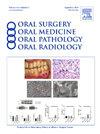Oral manifestations of syphilis: an alarming trend in Kuwait
IF 1.9
3区 医学
Q2 DENTISTRY, ORAL SURGERY & MEDICINE
Oral Surgery Oral Medicine Oral Pathology Oral Radiology
Pub Date : 2025-07-21
DOI:10.1016/j.oooo.2025.04.034
引用次数: 0
Abstract
Introduction
Syphilis, a sexually transmitted bacterial disease, is caused by Treponema pallidum (T. pallidum). The diagnosis of syphilis can be difficult without suspicion, and it’s made through serologic testing or direct detection of (T. pallidum) in biopsies. The stage at diagnosis and neurologic involvement determine the treatment.
Case Series
Eleven patients presented to different governmental clinics in Kuwait. Ten were males, and the patients ranged in age from 21 to 39.5 years old. While one patient had only a peri-anal lesion, the remainder presented with generalized oral/oropharyngeal painful lesions. The oral manifestations consisted of red/violaceous macules that progress into “waxy” mucosal thickening, “Mucus Patches.” Exophytic rough/papillary growth, “condylomata lata,” can develop. Less frequently, mucosal nodularity and “cobble-stoning,” similar to those seen in granulomatous processes, is observed. One peri-anal lesion from a male patient was only examined histologically in consultation and was clinically ulcerated pyogenic granuloma-like. Treponema IHC testing confirmed the diagnoses, while Warthin starry histochemical testing done on at least 5 cases was negative. Histologically, the lesions exhibited certain general diagnostically helpful features with different degree of manifestation across all biopsies. They are the presence of plasmacytic infiltrate submucosally, combined with the presence of neutrophils in the mucosal lining. Hyperplasia of the mucosa is helpful as well and can range from slight elongation of the rete ridges to a papillary/exophytic hyperplasia. The submucosal plasmacytic infiltrate also varies in the percentage of lymphocytes present and may extended deeper and with a perivascular pattern.
Conclusion
Syphilis can present a diagnostic challenge to unsuspecting diagnosticians. Oral lesions may be the first sign; thus dentists are on the frontline and must be familiar with it. Pathologists must be quick to test with Treponema IHC when certain histologic signs are observed in the biopsies. If misdiagnosed, or left untreated, the consequences can be a public health catastrophe.
梅毒的口腔表现:科威特令人担忧的趋势
梅毒是一种由梅毒螺旋体(T. pallidum)引起的性传播细菌疾病。没有怀疑,梅毒的诊断是很困难的,这是通过血清学测试或在活检中直接检测到梅毒。诊断阶段和神经受累程度决定了治疗方法。病例系列11例患者在科威特不同的政府诊所就诊。男性10例,年龄21 ~ 39.5岁。虽然一名患者只有肛门周围病变,但其余患者表现为广泛性口腔/口咽疼痛病变。口腔表现为红色/紫色斑,发展为“蜡样”粘膜增厚,“粘液斑”。外生性粗糙/乳头状生长,“尖锐湿疣”可以发展。较少见粘膜结节和“鹅卵石样结石”,类似于肉芽肿过程。一例男性患者肛周病变仅在会诊时进行了组织学检查,临床表现为溃疡性化脓性肉芽肿样。密螺旋体免疫组化检测证实了诊断,而对至少5例病例进行的Warthin星空组织化学检测为阴性。组织学上,病变表现出某些一般诊断有用的特征,在所有活检中表现出不同程度的表现。它们是存在于粘膜下的浆细胞浸润,同时存在于粘膜衬里的中性粒细胞。粘膜增生也有帮助,其范围可以从网状嵴的轻微伸长到乳头状/外生性增生。粘膜下浆细胞浸润在淋巴细胞的比例上也有所不同,并可向更深的方向扩展,呈血管周围浸润。结论梅毒对不知情的诊断人员具有诊断挑战性。口腔病变可能是第一个征兆;因此,牙医在第一线,必须熟悉它。当在活检中观察到某些组织学征象时,病理学家必须迅速进行密螺旋体免疫组化检查。如果误诊或不及时治疗,后果可能是一场公共卫生灾难。
本文章由计算机程序翻译,如有差异,请以英文原文为准。
求助全文
约1分钟内获得全文
求助全文
来源期刊

Oral Surgery Oral Medicine Oral Pathology Oral Radiology
DENTISTRY, ORAL SURGERY & MEDICINE-
CiteScore
3.80
自引率
6.90%
发文量
1217
审稿时长
2-4 weeks
期刊介绍:
Oral Surgery, Oral Medicine, Oral Pathology and Oral Radiology is required reading for anyone in the fields of oral surgery, oral medicine, oral pathology, oral radiology or advanced general practice dentistry. It is the only major dental journal that provides a practical and complete overview of the medical and surgical techniques of dental practice in four areas. Topics covered include such current issues as dental implants, treatment of HIV-infected patients, and evaluation and treatment of TMJ disorders. The official publication for nine societies, the Journal is recommended for initial purchase in the Brandon Hill study, Selected List of Books and Journals for the Small Medical Library.
 求助内容:
求助内容: 应助结果提醒方式:
应助结果提醒方式:


